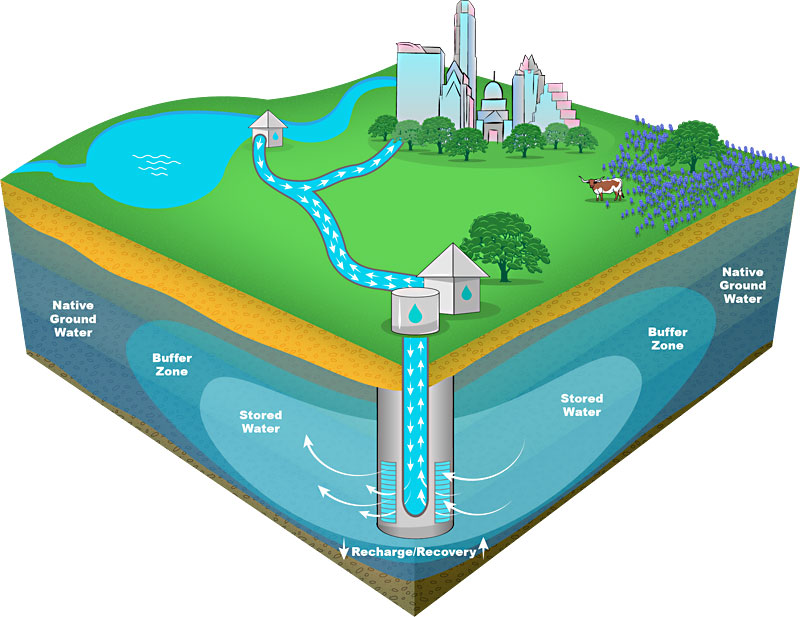Austin Water’s Aquifer Storage Project Steams Ahead
Project aims to store drinking water underground in the event of another supply issue
By Lina Fisher, Fri., April 1, 2022

After the third boil water notice in four years this February, Austinites are pondering ways to keep potable water on hand in case the water supply again proves unreliable. One such plan – the Aquifer Storage and Recovery Project (ASR) – has been in the works at Austin Water since the 2018 creation of the Water Forward Plan, a compendium of strategies for conservation and reuse for the next 100 years made in response to the 2008-16 drought, which reduced the Highland Lakes to historically low levels. On March 24, AW held the first of many planned town halls relating to ASR, which should store enough treated water in a nearby aquifer by 2035 to significantly bolster available supply in the event of another drought or freeze.
ASR essentially captures water from lakes in times of plentiful rainfall to treat, store underground, and pump back out during times of drought or other emergencies – like a water savings account, as AW describes it. ASR projects, which have proved successful in Kerrville, El Paso, and San Antonio, have many benefits, explained project leader Kristi Shaw: "Storing water underground in a natural aquifer prevents high evaporative losses that reservoirs experience in a warm climate, and is more cost effective than other similarly sized storage options." To protect the aquifer's health, water will be treated before it is pumped in, and then again when it comes out, to ensure it is compatible with the existing supply. The Carrizo-Wilcox and Trinity aquifers have been identified as contenders for the project, and a location will be finalized by 2023 after a geological survey, "based on not only aquifer considerations, but also endangered species, regulatory issues, and the distance to integration at Austin Water's system," said Shaw.
From 2024 to 2027, AW will pilot a small-scale version of ASR and in 2028 will begin design and construction on the full-scale version, with a projected end date of 2035. Based on the Water Forward Plan, the aquifer will include 60,000 acre-feet of storage by 2040. "For context," noted project manager Helen Gerlach, "the whole city of Austin used about 160,000 acre-feet in 2021 over the whole year. And that would be expanded out toward the end of the century, to have up to 90,000 acre-feet per year available by 2115."
People who tuned in to the meeting had several questions, mostly related to who can claim water ownership: One listener asked about interaction with groundwater conservation districts, which manage groundwater, to which AW replied that if the location they choose is within a GCD, they will "share information ... and work with them." Another asked if pumping would affect nearby farming and ranching operations – "I depend upon my water well for my livelihood and [when] a big operation [is] pumping water, my well goes down." AW promised that ASR "will never take out more water than was stored in the aquifer ... We'll never be removing groundwater that was already [there]." Treated water from rainfall that would be used in ASR is also subject to the rule of capture, which in Texas means that landowners can harvest any water that's under their land, regardless of the effects on nearby wells or aquifers. AW says it's a "key consideration, and as we identify locations, we'll be looking at different strategies to make sure that we are able to protect our water," such as buying the land above the aquifer and leasing it out to farmers and ranchers.
Jye Turk, AW's discussion moderator, clarified that "we are still in the very early stages" and promised that AW will be "working with the community throughout the process to share updates and gather feedback." Before the Zoom split into small-group discussions, the listener with the pumping question said, "I think the idea of reusing water sounds wonderful. But sometimes the devil is in the details."
Submit questions and learn more at www.speakupaustin.org/asr.
* Editor's note Thursday 3-31 5:52 pm: This story has been updated. We incorrectly stated that stormwater would be stored in the aquifer. Stormwater typically collects in creeks; the water from periods of heavy rainfall will come from Lake Travis and Highland Lakes. We regret the error.
Got something to say on the subject? Send a letter to the editor.








